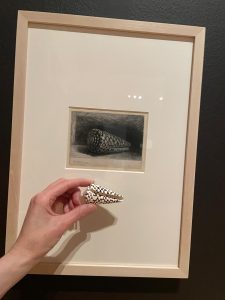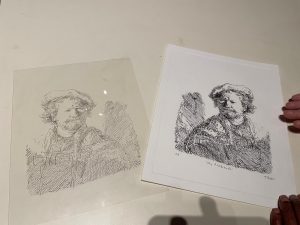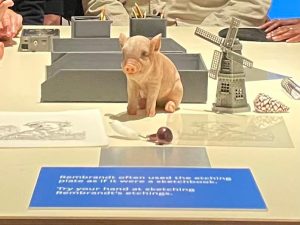SVI Members Explore Art Through Audio Description and Touch

On a Thursday afternoon in May, eight members from Sandwell Visually Impaired (SVI) and three from The Art Yard took a trip to Birmingham Museum & Art Gallery (BMAG) for a specially arranged tour of Rembrandt’s Masterpieces in Black & White.
Our group was met by the excellent BMAG Tour Guide Jane Hornby, who some of us remembered from the 2019 Leonardo exhibition, and Visitor Experience Assistant Sarah Z.
This is the first time the collection has left the Rembrandt House Museum in Amsterdam and the only opportunity to see the exhibition in the UK before its final showing in America this summer.
Jane guided us through a curated selection of the exhibition’s 44 black-and-white etchings, audio describing each one in a way that, as Sandra, SVI’s Development Worker, said: “really brought the pictures to life.”
Jane and Sarah Z produced several of the tools used to create the etchings, and Sonya remarked on the similarity between these tools and braille typewriters.
Ray appreciated the “good historical insight,” and Sonya described it as “very interesting.” Perm highlighted: “It was well paced, which, as a visually impaired person, I really appreciated!”
Everybody agreed the tour was creatively delivered. Richard Flatley, SVI Chair and instrumental in organising our bespoke exhibition experience, speaking on behalf of The Art Yard, said: “We marvelled, as a group, at how beautifully Rembrandt was able to summon up a landscape with so few deft strokes. Many of the images are of ordinary street people, portrayed with great dignity. We love his experiments, particularly in the self-portraits, where he portrays himself with a wide range of expressions.”
Tactile Highlights, Accessibility and Relatability
Several elements made this stand out as an accessible and sensory experience for SVI:
- Rembrandt’s prints were small compared to his paintings, and Jane and Sarah Z provided magnifying glasses and several A3 prints to assist with detail.
- Sarah Z accompanied us, wheeling a stack of foldable stools — which was a welcomed option.
- A tactile 3D replica of Rembrandt’s shell.
- A raised plastic etching of Rembrandt’s self-portrait, crafted by Jeremy Ross, retired Head of the Birmingham Museums Trust.

Rembrandt’s shell and accompanying tactile 3D replica of Rembrandt’s shell. 
Rembrandt’s self-portrait and a tactile plastic etching of Rembrandt’s self-portrait. 
Examples of tactile art used for the Rembrandt exhibition touch tour.
Jane included a description of Blind Fiddler and Dog, dated 1631. The blind fiddler plays his violin as his terrier, tied by a rope to the fiddler’s belt, guides him along the street.
Also appreciated were a model of a Dutch windmill and a small pig sculpture — sensory features, storytelling and audio descriptions that made the exhibition accessible and memorable.
How It Could Be Better
The touch tour and audio description were memorable, engaging and thoughtful — what we’d call a “good tour.” With a few small changes, it could become excellent:
- A brief audio description of the exhibition layout to help visitors understand the space before entering.
- The accompanying video would have benefitted from audio description, especially avoiding vague terms like “this tool here.”
- An accompanying hands-on opportunity immediately after the video to try Rembrandt’s printing technique—as demonstrated in the footage—would have helped deepen understanding of how he created his masterpieces.
Richard said, “We know that Jane Hornby prepared this guided tour solely for the benefit of our visit. For this, we are truly grateful. All of the staff could not have made us feel more welcome — particularly Sarah Z.”
It was particularly thoughtful of Creative Black Country to include tea and biscuits after the tour. This gave us time to chat about the exhibition, share how we felt about the experience and, most importantly, fill in our feedback forms.
SVI would like to thank BMAG and Creative Black Country for making this tour possible, and Sarah-Ann and Sam for their sighted assistants. Events like this not only enable access to visual art for our members — they also offer a model for other institutions to follow.
If you’d like advice on how to improve accessibility for visually impaired visitors, please visit the SVI Accessibility page.
Written by Sarah-Ann Cromwell SVI Sighted Guide and Accessibility Consultant and Richard Flatley SVI Chair with contributions from SVI members